人教版七年级英语上册知识点整理
(完整版)人教版七年级上册英语全册语法知识点梳理,推荐文档

第一讲:动词一.Be 动词(am, is, are)的用法口诀:I 用 am , you 用 are ,is 连着他(he)她(she)它(it)。
单数全部用 is,复数一律都用 are. 变疑问,往前提,句末问号莫丢弃,变否定,更容易,be 后 not 莫忘记,句首大写莫迟疑。
I a student. You Japanese.He my brother. She very nice.My name Harry. LiLei very tall.This book very interesting. Li Lei and I good friends.These apples. Those bananas.They students. There some bread on the plate.The cat black. The black pants for Su Yang.Here some sweaters for you. There a girl in the room.There some milk for me. There some apples on the tree.Gao Shan's shirt over there. Some tea in the glass.二.一般现在时态1.用法:(1).表示习惯性,经常性的动作,常与o f t e n,a l w a y s,u s u a ll y,e v e r y d a y/w ee k/m o n t h…等词连用I o f t e n p l a y s o cc e r.(2).表示主语具备的性格或能力:H e li k e s t o e a t b a n a n a s.2.在一般现在时态中,当主语是第三人称单数时,谓语动词也用第三人称单数, 第三人称单数的构成规则(主语不是第三人称单数时谓语动词用原形):a.一般情况下在动词词尾加 s 如:get----gets like----likes play—plays, want—wants,work—works,b.以字母 s、x、ch, sh,o 结尾的动词加-es:guess—guesses, fix—fixes, teach—teaches,brush—brushes, go—goes,c.以辅音字母+y 结尾的动词,先变y 为i,再加-es:study—studies,carry—carries,fly—flies,特殊词: have --- has一写出下列动词的三单形式。
人教版初中英语七年级上册语法知识点
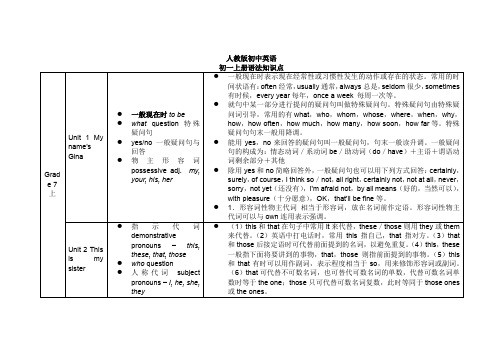
have表示“有”时,其否定形式有两种:在其后直接加not,但常用于非正式用语中;利用助动词do加not。
②如果句子的谓语是实义动词,在谓语动词前加don't,doesn't,didn't。
③no,never,seldom,hardly,nobody,little,few,nothing等否定词也可以构成否定形式。
1.表示经常性或习惯性发生的动作2.表示现在存在的状态或情况3.表示正在发生的动作或存在的状态4.表示客观事实、真理和自然现象5.用于表示较固定的、按计划、规定将要发生的动作,但只限于begin,come,go,leave,arrive,stop,return,close,open,take,start,take,place等少数动作,6.用于if,unless,once,even if(即使)等引导的条件状语从句,when,before,until,as soon as,the moment(一……就)等引导的时间状语从句,no matter+wh-/-how-或wh-ever/however等引导的让步状语从句中,代替一般将来时
人教版初中英语
初一上册语法知识点
Grade 7
上
Unit 1 My name’s Gina
人教版七年级上册英语知识点总结
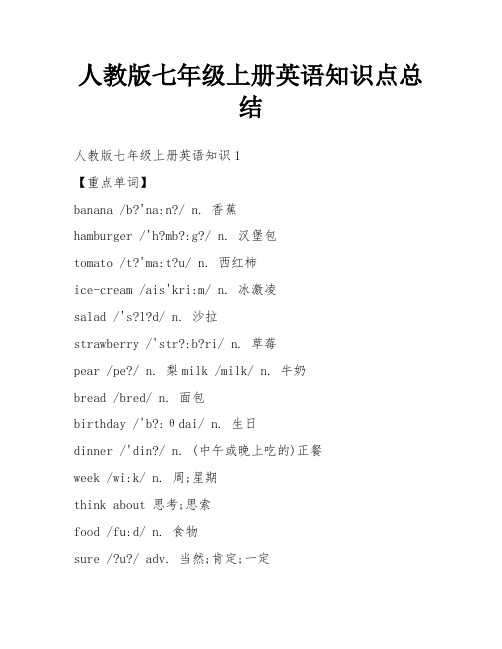
人教版七年级上册英语知识点总结人教版七年级上册英语知识1【重点单词】banana /b?'na:n?/ n. 香蕉hamburger /'h?mb?:g?/ n. 汉堡包tomato /t?'ma:t?u/ n. 西红柿ice-cream /ais'kri:m/ n. 冰激凌salad /'s?l?d/ n. 沙拉strawberry /'str?:b?ri/ n. 草莓pear /pe?/ n. 梨milk /milk/ n. 牛奶bread /bred/ n. 面包birthday /'b?:θdai/ n. 生日dinner /'din?/ n. (中午或晚上吃的)正餐week /wi:k/ n. 周;星期think about 思考;思索food /fu:d/ n. 食物sure /?u?/ adv. 当然;肯定;一定How about...? (提出建议)......怎么样? burger /'b?:g?/ n. (=hamburger)汉堡包vegetable /'ved?t?bl/ n. 蔬菜fruit /fru:t/ n. 水果right /rait/ adj. 正确的;适当的apple /'?pl/ n. 苹果then /?en/ adv. 那么egg /eg/ n. 蛋;鸡蛋carrot /'k?r?t/ n. 胡萝卜rice /rais/ n. 大米;米饭chicken /'t?ikin/ n. 鸡肉so /s?u/ conj. (引出评论或问题)那么breakfast /'brekf?st/ n. 早餐;早饭lunch /l?nt?/ n. 午餐star /sta:/ n. 明星;星星eat /i:t/ v. 吃well /wel/ adv. 好;令人满意地habit /'h?bit/ n. 习惯healthy /'helθi/ adj. 健康的really /'ri:?li/ adv. 真正地question /'kwest??n/ n. 问题want /w?nt/ v. 需要;想要be /bi:/ v. 变成fat /f?t/ adj. 肥的;肥胖的一.短语归纳1.John’s birthdaydinner 约翰的生日晚餐2.next week 下周3.think about 思考、考虑4.how about 怎么样5.some fruit 一些水果6.his birthday 他的生日7.sport star 体育明星 8.eating habits 饮食习惯9.for breakfast 作为早餐 10.for dinner 作为晚餐11.one lastquestion 最后一个问题 12.healthy food 健康的食品二.重点句型:1.have sth 吃……2.—Do you like…? 你喜欢…吗?—Yes, I do / No, I don’t. 是的,我喜欢/不,我不喜欢。
人教版七年级上册英语重点知识点

人教版七年级上册英语重点知识点一、英语字母和发音英语字母共有26个,包括五个元音字母a、e、i、o、u和21个辅音字母。
每个字母都有自己的发音,需要正确掌握。
二、日常用语和问候1. 问候语(Greetings): Good morning!(早上好!)Good afternoon!(下午好!)Good evening!(晚上好!)Hi!(嗨!)Hello!(你好!)2. 自我介绍(Introductions):My name is…(我叫……)I am…years old.(我……岁了。
)3. 询问他人身份(Asking about someone):What's your name?(你叫什么名字?)How old are you?(你多大了?)三、数字和时间表达1. 数字(Numbers):英语中使用阿拉伯数字表示数字,例如:0、1、2、3等。
2. 时间表达(Time expressions):What time is it?(现在几点了?)It's ______ o'clock.(现在是几点。
)表示差几点,用英语表述多少点前或多少点后。
四、日常用语及对话1. 询问和回答(Asking and answering):- What’s this in English?(这个用英语怎么说?)- It’s a/an _______.(这是一个……。
)2. 问路(Asking for directions):- Excuse me, where is the _______?(请问,_______在哪里?)- Go straight and turn left/right.(一直直走然后左转/右转。
)五、课堂用语及对话1. 请假(Asking for leave):- Can I go to the toilet, please?(我可以去洗手间吗?)- May I leave the classroom?(我可以离开教室吗?)2. 求救(Asking for help):- Help me, please!(请帮帮我!)- Can you help me?(你能帮助我吗?)六、家庭成员1. 父亲(Father):father/dad/daddy2. 母亲(Mother):mother/mom/mummy3. 儿子(Son):son4. 女儿(Daughter):daughter5. 兄弟(Brother):brother6. 姐妹(Sister):sister七、日常动词1. 是(be):am/is/are2. 有(have):have/has3. 去(go):go/goes4. 学习(study):study/studies5. 做(do):do/does6. 看(watch):watch/watches7. 喜欢(like):like/likes8. 在(in):in9. 玩(play):play/plays10. 坐(sit):sit/sits以上是人教版七年级上册英语的部分重点知识点,希望对你的学习有所帮助。
人教版英语七年级上册知识点
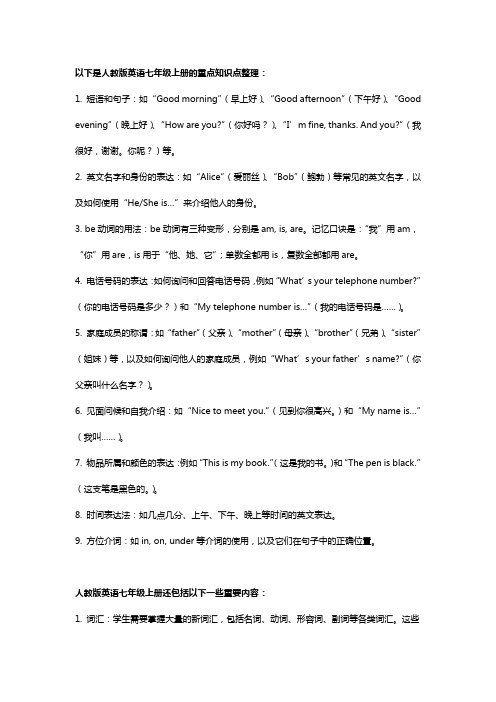
以下是人教版英语七年级上册的重点知识点整理:1. 短语和句子:如“Good morning”(早上好)、“Good afternoon”(下午好)、“Good evening”(晚上好)、“How are you?”(你好吗?)、“I’m fine, thanks. And you?”(我很好,谢谢。
你呢?)等。
2. 英文名字和身份的表达:如“Alice”(爱丽丝)、“Bob”(鲍勃)等常见的英文名字,以及如何使用“He/She is…”来介绍他人的身份。
3. be动词的用法:be动词有三种变形,分别是am, is, are。
记忆口诀是:“我”用am,“你”用are,is用于“他、她、它”;单数全都用is,复数全部都用are。
4. 电话号码的表达:如何询问和回答电话号码,例如“What’s your telephone number?”(你的电话号码是多少?)和“My telephone number is…”(我的电话号码是……)。
5. 家庭成员的称谓:如“father”(父亲)、“mother”(母亲)、“brother”(兄弟)、“sister”(姐妹)等,以及如何询问他人的家庭成员,例如“What’s your father’s name?”(你父亲叫什么名字?)。
6. 见面问候和自我介绍:如“Nice to meet you.”(见到你很高兴。
)和“My name is…”(我叫……)。
7. 物品所属和颜色的表达:例如“This is my book.”(这是我的书。
)和“The pen is black.”(这支笔是黑色的。
)。
8. 时间表达法:如几点几分、上午、下午、晚上等时间的英文表达。
9. 方位介词:如in, on, under等介词的使用,以及它们在句子中的正确位置。
人教版英语七年级上册还包括以下一些重要内容:1. 词汇:学生需要掌握大量的新词汇,包括名词、动词、形容词、副词等各类词汇。
人教版英语七年级上册知识点、语法总结
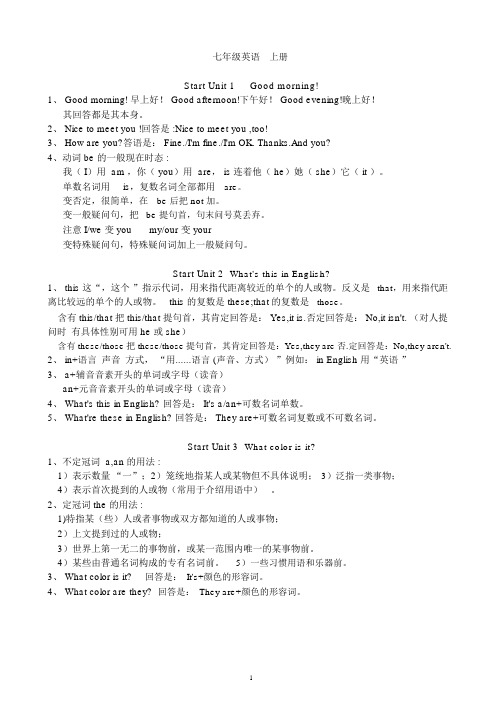
七年级英语上册Start Unit 1Good morning!1、 Good morning! 早上好! Good afternoon!下午好! Good evening!晚上好!其回答都是其本身。
2、 Nice to meet you !回答是 :Nice to meet you ,too!3、 How are you?答语是: Fine./I'm fine./I'm OK. Thanks.And you?4、动词 be 的一般现在时态 :我( I)用 am ,你( you)用 are, is 连着他( he)她( she)它( it )。
单数名词用is,复数名词全部都用are。
变否定,很简单,在be 后把 not 加。
变一般疑问句,把be 提句首,句末问号莫丢弃。
注意 I/we 变 you my/our 变 your变特殊疑问句,特殊疑问词加上一般疑问句。
Start Unit 2What's this in English?1、 this 这“,这个”指示代词,用来指代距离较近的单个的人或物。
反义是that,用来指代距离比较远的单个的人或物。
this 的复数是 these;that的复数是those。
含有 this/that 把 this/that 提句首,其肯定回答是: Yes,it is.否定回答是: No,it isn't. (对人提问时有具体性别可用 he 或 she)含有 these/those把 these/those提句首,其肯定回答是:Yes,they are否.定回答是:No,they aren't.2、 in+语言声音方式,“用......语言 (声音、方式)”例如: in English 用“英语”3、 a+辅音音素开头的单词或字母(读音)an+元音音素开头的单词或字母(读音)4、 What's this in English? 回答是: It's a/an+可数名词单数。
人教版七年级英语上册-重要知识点笔记归纳
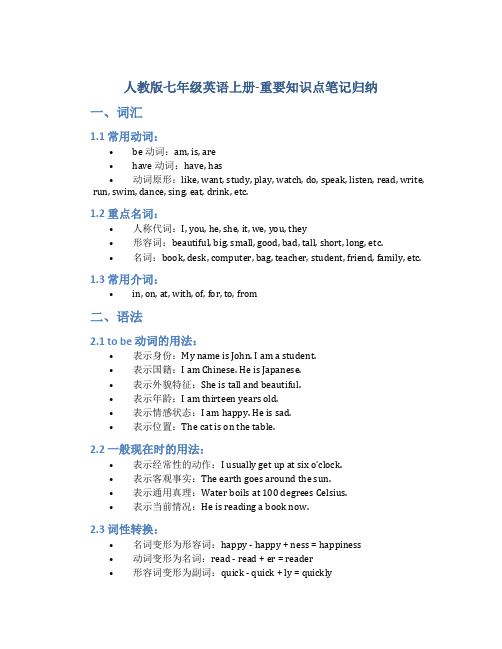
人教版七年级英语上册-重要知识点笔记归纳一、词汇1.1 常用动词:•be 动词:am, is, are•have 动词:have, has•动词原形:like, want, study, play, watch, do, speak, listen, read, write, run, swim, dance, sing, eat, drink, etc.1.2 重点名词:•人称代词:I, you, he, she, it, we, you, they•形容词:beautiful, big, small, good, bad, tall, short, long, etc.•名词:book, desk, computer, bag, teacher, student, friend, family, etc.1.3 常用介词:•in, on, at, with, of, for, to, from二、语法2.1 to be 动词的用法:•表示身份:My name is John. I am a student.•表示国籍:I am Chinese. He is Japanese.•表示外貌特征:She is tall and beautiful.•表示年龄:I am thirteen years old.•表示情感状态:I am happy. He is sad.•表示位置:The cat is on the table.2.2 一般现在时的用法:•表示经常性的动作:I usually get up at six o’clock.•表示客观事实:The earth goes around the sun.•表示通用真理:Water boils at 100 degrees Celsius.•表示当前情况:He is reading a book now.2.3 词性转换:•名词变形为形容词:happy - happy + ness = happiness•动词变形为名词:read - read + er = reader•形容词变形为副词:quick - quick + ly = quickly三、基础句型3.1 be 动词句型:•肯定句:I am a student. / He is my friend.•否定句:I am not a teacher. / She is not tall.•疑问句:Are you Chinese? / Is he a doctor?3.2 一般现在时句型:•肯定句:I usually go to school by bus.•否定句:I don’t like sports.•疑问句:Do you like pizza? / Does she speak English?3.3 祈使句:•意义:表示命令、请求、建议等。
新版人教版七年级英语上册各单元知识点

空间
form Monday to Friday 从周一到周五
form Beijing to Shanghai 从北京到上海
6.finish的用法
finish作不及物动词时,意为“完成;做好”
They start work early and finish late every day.他们每天开工早收工晚。
作及物动词,后接动词时,要用动名词形式,即finish doing sth. 表示“做完某事,
完成某事”
Jim usually finishes doing his homework before 8:00.吉姆通常在8点前做完作业。
7.thank sb for的用法:
thank sb for意为“因……而感谢某人”,for是介词,后接名词、代词或动名词,表感
谢的原因或内容。
Thank him for telling me. 谢谢他告诉我。
Thank you for helping with my English.多谢你帮我学英语。
8.for two hours的用法:
“for+一段时间”是介词短语,意为“……时间”,表示某事持续多长时间。
对其提问要用
how long
—How long will you stay in Beijing 你将在北京待多长时间?
—For about three days. 大约三天。
- 1、下载文档前请自行甄别文档内容的完整性,平台不提供额外的编辑、内容补充、找答案等附加服务。
- 2、"仅部分预览"的文档,不可在线预览部分如存在完整性等问题,可反馈申请退款(可完整预览的文档不适用该条件!)。
- 3、如文档侵犯您的权益,请联系客服反馈,我们会尽快为您处理(人工客服工作时间:9:00-18:30)。
七年级下册英语各单元知识点大归纳Unit 1 Can you play the guitar?1、be busy doing sth/ be busy with sth 因某事繁忙7、need to do sth 需要做某事2、How/ what about+V-ing …怎么样?(表建议)8、call sb at +电话号码3、have friends= make friends 交朋友9、on the weekend= on weekends 在周末4、like/love doing/to do sth 喜欢做某事10、play +球类/棋类,play+ the+ 乐器5、want= would like +(sb)to do sth 想要做某事11、do Chinese kung fu表演中国功夫6、have an e-mail address 有电子邮件的地址12、be free= have time 有时间13、特殊疑问句的构成:疑问词+一般疑问句14、show sth to sb=show sb sth向某人展示某物give sth to sb=give sb sth给某人某物15、情态动词+V原can do= be able(adj. 能够的)to do 能够做某事16、感官动词(look, sound, taste, smell, feel)+adj/ like e.g. That sounds good.17、选择疑问句:回答不能直接用Yes或者No,要从中选择一个回答18、be in参加,加入join+俱乐部join in+活动join the art club 加入艺术俱乐部19、English-speaking students 说英语的学生(带有连词符,有形容词性质)20、4个说的区别:say+所说内容say it in English 用英语说它speak+语言speak English 说英语speak a little English 说一点英语talk 谈论(双方)talk about sth 谈论某事talk with sb talk to sbtell 告诉,讲述(单方面)tell sb(not)to do sth 告诉某人(不要)做某事tell stories/ jokes 讲故事/笑话21、good的用法be good at+ V-ing=do well in 擅长于be good for 对…有益(be bad for对…有害)be good to 对…友好(good 可用friendly,nice,kind替换)be good with和…相处好=get on/ along well with23、help的用法help sb (to)do sth 帮助某人做某事,to可以省略help sb with(doing)sth 帮助某人(做)某事,with(介词)后面接动词ingw ith sb’s help= with the help of sb在某人的帮助下help oneself to 随便享用1Unit 2 What time do you go to school?1、go to school 去上学8、get up 起床2、brush teeth 刷牙9、get to 到达3、go to work 去上班10、go home 回家4、either…or… 要么…要么…11、go to bed 上床睡觉5、radio station 广播电台12、take/have a walk 散步6、be late for=arrive late for 迟到13、get home 到家7、take a shower 洗淋浴14、do homework 做家庭作业15、from…to…从…到…from home to school 从家到学校16、一段时间前面要用介词for for half an hour for five minutes17、频度副词always/usually/often/sometimes/seldom/hardly/never:形前be后18、eat/ have…for breakfast/ lunch/ dinner/ supper 吃……作为早餐/午餐/晚餐20、问时间用what time或者whenat+钟点at 7 o’clock at noon/ at night(during/ in the day)on+ 具体某天、星期、特指的一天on April 1st on Sunday on a cold winter morning in +年、月、上午、下午、晚上in the morning/ afternoon/ evening 在上午/下午/晚上21、时间读法:顺读法:10:30 ten thirty逆读法:分钟≤30用past(超过)five past eight(8:05)half past eight(8:30)分钟>30用to(欠) a quarter to ten(9:45)整点用o’clock 7 o’clock(7:00)22、3个穿的区别wear 表状态,接服装、手套、眼镜、香水等put on 表动作,接服装dress 表动作,接sb/ oneself get dressed穿衣23、感叹句How+adj+主谓!How interesting it is!How+adj+a/an +n单+主谓!How clever a boy he is!What+ a/an +adj+ n单+主谓!What a clever boy he is!What+ adj+ n复/ 不可数+主谓!What cute the girls they are!24、it is +adj+for sb +to do sth (adj修饰to do sth)做sth对sb来说是…It is important for me to learn English. 学习英语对我而言是非常重要的。
it is +adj+of sb +to do sth (adj修饰sb)某人做某事是怎样的It is kind/ friendly/ nice of you to help me. 你非常友好的帮助我。
Unit 3 How do you get to school?1、穿过cross 是动词across是介词8、think of 认为2、between … and … 在…和…之间9、come true 实现3、worry about be worried about 担心10、every day每天4、leave for 出发前往某地leave离开11、have to 不得不5、many students= many of the students 许多学生12、play with … 和…玩6、be afraid to do / of doing sth 害怕(做)某事13、bus stop 公共汽车站7、he is like (像) a father to me 他对我而言像一位父亲14、get to school 到达学校15、how far is it from …to …? 从…到…有多远?16、how long does it take to do sth.? …花费多长时间?17、how do / does (sb)get to …? …是怎样到…的?How do you get to school? I ride my bike.18、what do you think of/ about…?= how do you like…?你认为…怎么样19、a 11-year-old boy 一个11岁的男孩(有连字符为形容词) He is 11 years old. 他11岁。
20、how 如何(方式)how long 多长(时间)答语常用“(For/ about +)时间段”how far多远(距离)答语常用“(It’s +)数词+miles/ meters/ kilometers”how often多久一次(频率)答语常用“Always/ often/ every day/…”或“次数+时间”how soon多快,多久以后,常用在将来时中。
答语常用“in +时间段”how many多少(接可数名词)how much(接不可数名词)why为什么(原因)what什么when何时who谁whom谁(宾格)(针对宾语提问也可用who)宾语从句要用陈述句语序whose谁的21、stop的用法:stop sb from doing sth 停止做某事stop to do 停下来去做其他事stop to sing 停下来去唱歌stop doing 停止正在做的事stop singing 停止唱歌22、4个花费:人+spend/ spends/ spent+时间/钱+(in)doing sth/ on sth人+pay/ pays/ paid +钱+for sthIt takes/ took sb +时间/时间+to do sth物+cost/ costs/ cost +sb +钱23、thanks for +n/ V-ing 感谢某人某事Thanks for your help/ thanks for helping me.Thanks for your invitation(n.邀请)/ thanks for inviting/ asking me. (invite v.邀请)Thanks to幸亏,由于,因为24、交通方式●用介词。
在句子中做方式状语。
(1)by +交通工具名词(中间无需任何修饰)By bus/ bike/ car/ taxi/ ship/ boat/ plane/ subway/ train……(2)by +交通路线的位置By land/ water/ sea/ air(3)in/ on +冠词/物主代词/指示代词+交通工具名词In a/ his/ the car On a/ his/ the bus/ bike/ship(4)on foot 步行●用动词。
在句子中做谓语。
(1)take + a/ the +交通工具名词take a bus/ plane/ ship/ train ride a bike(2)walk/ drive/ ride/ fly to……后面接here,there,home等地点副词时,省略介词to。
如步行回家:walk home25、名词所有格(1)一般情况加’s (Tom’s pen),以s结尾直接加’ (the teacher’ office教师们的办公室)(2)表示几个人共同拥有,在最后一个名词后加’s Mike and John’s desk(只有一张桌子)(3)表示每个人各自拥有,在每个名词后加’s Mike’s and John’ s desks(两张桌子)3Unit 4 Don’t eat in class.1.、listen to …听……listen to music 听音乐9、be quiet 安静2、in class在课堂上in the classroom 在教室. 10、go out 外出3、practice (doing) sth 练习做某事11、be noisy 吵闹4、keep one’s hair short 留短发12、(be)on time 准时,按时5、make (one’s) bed 铺床13、bring…to…把…带来6、learn to do sth. 学会做某事14、make breakfast 做早饭7、leave sth sp. 把某物忘在某地15、eat outside在外面吃饭8、wash / do the dishes 洗盘子16、some of…+名词复数……当中的一些17、on school days/ nights 在学校的日子/夜晚18、(have a)fight with sb和某人打架fighting 加油19、be strict with sb/ oneself be strict in sth对……严格20、remember/ forget + to do记得/忘记做某事(事情还没做)+ doing记得/忘记做过某事(事情已经做了)21、break/ follow(obey)the rules打破/遵守规则make rules 制订规则22、have a good / great / wonderful time / have fun +(in) doing sth 过得很愉快23、keep + 宾语+形容词使……保持某种状态keep the dog quiet 让狗保持安静24、get to, arrive in/at, reach,到达(如果后面接地点的副词home,here或there ,就不用介词in ,at, to)25、too many“太多”修饰可数名词复数too much“太多”修饰不可数名词much too“实在太”修饰形容词或副词26、must 与have to(1)must 表示说话人主观上的看法,意为“必须”。
